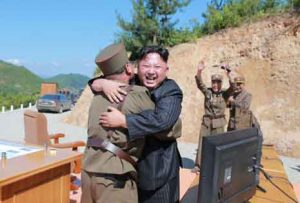
UNITED NATIONS / PENTAGON — The United States told U.N. Security Council members Wednesday it is prepared to use military means to defend against the threat posed by North Korea’s launch of an intercontinental ballistic missile, but that it would be best to try to resolve the crisis through diplomatic and economic measures.
Ambassador Nikki Haley said the “considerable military forces” the United States has in east Asia are at the ready. She told Security Council members at an emergency meeting Wednesday: “We will use them if we must, but we prefer not to have to go in that direction.”
North Korea’s launch of an ICBM for the first time triggered widespread condemnation and an immediate diplomatic crisis. Parts of North America are believed to be in range of the new multistage rocket Pyongyang test-fired Tuesday.
Overall threat still limited
U.S. military officials said there were multiple reasons to be concerned about the North Korean action, but that the overall threat to the U.S. and its allies — Japan and South Korea, in particular — is still limited.
Haley said the United States will propose new sanctions against North Korea shortly. A new draft resolution will be circulated among Security Council members “in the coming days,” she noted, adding the measure “raises the international response in a way that’s proportionate to North Korea’s escalation.”
Among new sanctions under consideration, U.S. officials indicated, are restrictions on the flow of oil and other energy supplies to Pyongyang’s military and weapons programs, tightened controls over air and maritime traffic to North Korea, and further moves to hold senior officials of the Kim Jong Un regime accountable for the country’s defiance of international demands to shut down its nuclear-weapons development program.
The U.S. and China remain far apart on what to do about North Korea, and Beijing’s response to the next U.S. move on North Korea will be key to the success of the American effort.
In a clear reference to China, the U.S. ambassador said: “There are countries allowing, even encouraging, trade with North Korea in violation of U.N. Security Council resolutions. Such countries would also like to continue their trade arrangements with the United States.
“That’s not going to happen,” Haley said, warning that President Donald Trump’s administration is willing to use its “great capabilities in the area of trade” when countries do not take international security threats seriously.
China-North Korea trade
China is North Korea’s largest commercial partner, and the trade volume between the two countries rose 37.4 percent in the first part of this year, according to Chinese data released in April.
China did announce in February it was suspending all coal imports from North Korea through the end of 2017, to comply with the U.N. sanctions program. Coal is Pyongyang’s single largest export, and the Chinese action could cost Pyongyang hundreds of millions of dollars.[xyz-ihs snippet=”adsense-body-ad”]China’s U.N. ambassador, Liu Jieyi, said the North Korean missile launch was “unacceptable” and a “flagrant violation” of U.N. resolutions, but he did not say whether Beijing would support new sanctions, and he dismissed the idea of a military solution to the crisis on the Korean peninsula.
China proposed a resolution calling on Pyongyang to suspend its military programs and for the United States and South Korea to likewise suspend their annual joint military exercises. The U.S. has so far rejected this idea.
U.S. military officials said Pyongyang’s first-ever demonstration of an intercontinental weapon caught the world’s attention, and they warned that the window of opportunity for resolving tensions on the Korean peninsula is “quickly closing.”
Missile launch ‘has our attention’
The United States tracked the two-stage ICBM for 37 minutes after it took off from a mobile launcher Tuesday near Panghyon Airport. Experts said the rocket was fired in a very steep orbit, rising far above Earth’s atmosphere before splashing down in the Sea of Japan.
The missile carried a re-entry vehicle, they said, which apparently was intended to demonstrate it could withstand the intense heat of a high-speed descent through the atmosphere. The re-entry capsule could be used to carry a nuclear warhead, but it is uncertain whether North Korea has yet developed the technology to miniaturize and “ruggedize” a nuclear device for such a ballistic flight.
The missile, which fell into the sea due west of the Tsugaru Strait, “is not one we’ve seen before,” Pentagon spokesman Capt. Jeff Davis told reporters Wednesday. He said the new rocket apparently would be capable of traveling more than 5,500 kilometers — a range that could reach Alaska and parts of Canada, but not Hawaii or the contiguous 48 U.S. “mainland” states.
Nevertheless, Davis said, the new weapon “has our attention.”
“This was a test launch,” the Pentagon spokesman added. “It was not assessed to be posing a threat to the United States or our allies.
“We do have confidence in our ability to defend against the limited threat, the nascent threat that is there,” Davis said.
In a test last month, a U.S.-based missile interceptor knocked down a simulated incoming North Korean ICBM. Other tests of the system, however, have met with mixed results.
The Defense Department assessment came as the North Korean leader boasted about the missile launch. Kim told a group of scientists and technicians the new rocket was “a package of gifts” timed to coincide with the U.S. Independence Day holiday.
The regime’s Korean Central News Agency said Kim expected the U.S. would be “displeased” by Pyongyang’s achievement, and urged his scientists to conduct further tests as “big and small ‘gift packages’ to the Yankees.”
Joyce Huang and Saibal Dasgupta contributed to this report.
Source: VOA [xyz-ihs snippet=”Adsense-responsive”]
